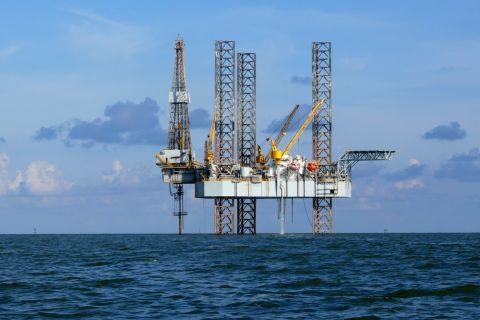
SAN ANTONIO—The year 2015 may be tough, but for midstream companies this isn’t a slump.
While companies may be more cautious with capex than in years past, midstream has thrived even as its E&P cousins have suffered.
“This industry has never seen a challenge it couldn’t overcome,” said Barry Davis, EnLink Midstream CEO. Davis spoke Oct. 26 at Hart Energy’s Midstream Texas conference in San Antonio.
During his keynote, Davis showed a photo of a man climbing a rocky surface; then another from a greater distance, showing the climber was perhaps five feet from the ground.
With a little more perspective, Davis said, challenges seem less insurmountable.
Davis noted that the midstream sector continues to thrive. In the 1990s, investment in midstream infrastructure was about $2- to $3 billion for years. Since 2005, it has grown to $30 billion a year.
“When we look forward, we believe that we will continue to see $20- to $30 billion a year in midstream infrastructure investments in this business,” Davis said. “We’ve seen a tenfold increase in the last 10 years in the midstream industry, and this is great news for all of us.”
In his opening keynote, “Texas’ Outsized Role in the Midstream Buildout,” Davis was upbeat about midstream infrastructure investments and the industry overall.
Davis said a day in the life of the industry is about the intensity of the challenges people face.
Yet the industry is well equipped for the challenges it’s up against.
Now is a “great time to do great things in this industry,” he said.
So far in 2015, midstream infrastructure has generated about 21 announced deals worth at least $1 billion each.
EnLink itself has made seven deals valued at $2.9 billion, including dropdowns and acquisitions in Texas, Oklahoma and Ohio. Most recently, it closed a $143 million deal with Matador Resources Co. on Oct. 1.
“We believe there are opportunities to do things in all cycles,” Davis said.
Cyclical Industry
Working in the oil and gas industry can mean a predictable but bumpy ride.
“If this is a cyclical business, we have to gain some confidence in what we’ve been able to do as an industry to overcome the challenges that we faced in the past,” Davis said
While the past 12 months have been tough—commodity prices have fallen by an average 50%—that’s a far cry from some downcycles:
- 2008-09, oil prices plummeted 77%;
- 2000-02, prices fell 50%;
- 1997-98, fell by 56%; and
- 1985-86, fell by 70%.
“This ain’t our first rodeo. We’ve seen these challenges and lower oil prices, and we always recover,” Davis said.
Midstream companies are also largely insulated in short term commodity price fluctuations because of fee-based contractors with E&Ps. EnLink, for instance, generates about 95% of gross operating margin from fee-based contracts.
Technological Prowess
The strength of the shale oil and gas boom has created huge surplus in gas and oil—and a threat to OPEC’s power.
In part, technological developments have returned the U.S. to energy superpower status.
“The technology progression has changed the world in which we operate.”
In 2005, the average natural gas price in 2005 was $9.01 per million Btu (MMBtu).
By 2015, supply had so overtaken demand that prices fell to $2.75/MMBtu.
“We’ve become more productive in terms of the drilling that we do today,” Davis said. “A well that would have taken 33 days to drill in 2005 can be drilled in less than 20 days in 2015. In fact, in the Eagle Ford, a well [drilled] today is closer to 10 days than 20 days."
When the gas rig count peaked, the industry had almost 1,800 rigs running. Today, there are 90% less rigs in place and production continues to grow.
Growth Galore
The shale gas revolution has brought about a dramatic change in the energy industry, Davis said.
From 2005 to 2015, gas production increased by 57% from 50 Bcf/d to more than 70 Bcf/d. Crude oil output has increased by 82% to more than 9 million barrels per day (MMbbl/d) from 5 MMbbl/d.
NGL produced at processing plants shot up by 120%.
“This is an extraordinary period of growth for our industry,” Davis said.
With power generation, industrial growth and LNG exports ahead, greater demand for natural gas should come.
Davis said he sees the industry’s demand growth continuing through 2020.
Gas demand will continue to be driven by everything in the Gulf Coast, he continued.
Power generation will continue to grow in the South and Southeast.
In 2016, LNG exports will make for a breakthrough year, as shipments move out from the Gulf Coast.
Large industrial demand growth will be seen on the Gulf Coast as well.
The industry has moved from 60% of the oil being imported to about 30%.
“We as a country will be independent and will actually be a net exporter of energy products,” Davis said.
In addition, NGL demand is the area where “a tremendous difference” has been made in the industry’s ability to compete around the world from an industrial standpoint because of the low cost of NGL products, he said. “It’s a great thing for our country as we’ve seen the shale revolution continue.”
Ariana Benavidez can be reached at abenavidez@hartenergy.com.
Recommended Reading
Supreme Court Takes Up Clean Air Act Venue Fight
2024-10-21 - The high court’s justices will hear arguments if the EPA’s air pollution rules should be challenged in D.C. or in regional courts.
Construction on Kinder Morgan’s Tennessee Pipeline Delayed by Stay
2024-10-15 - An appeals court panel put two permits on hold for Kinder Morgan’s pipeline to consider the project’s implications on the Clean Water Act.
LNG Sector Under Fire as Activists’ Lawsuits Surge
2024-10-10 - ESG litigation is increasingly affecting the LNG industry while, more broadly, nearly 70% of climate-related cases are filed in the U.S.
Industry Warns Ruling Could Disrupt GoM Oil, Gas Production
2024-09-12 - The energy industry slammed a reversal on a 2020 biological opinion that may potentially put an indefinite stop to oil and gas operations in the Gulf of Mexico—by December.
California Sues Exxon Over Global Plastic Pollution
2024-09-23 - The investigation mirrors California's previous probes into the oil industry's alleged efforts to mislead the public about climate change.
Comments
Add new comment
This conversation is moderated according to Hart Energy community rules. Please read the rules before joining the discussion. If you’re experiencing any technical problems, please contact our customer care team.




